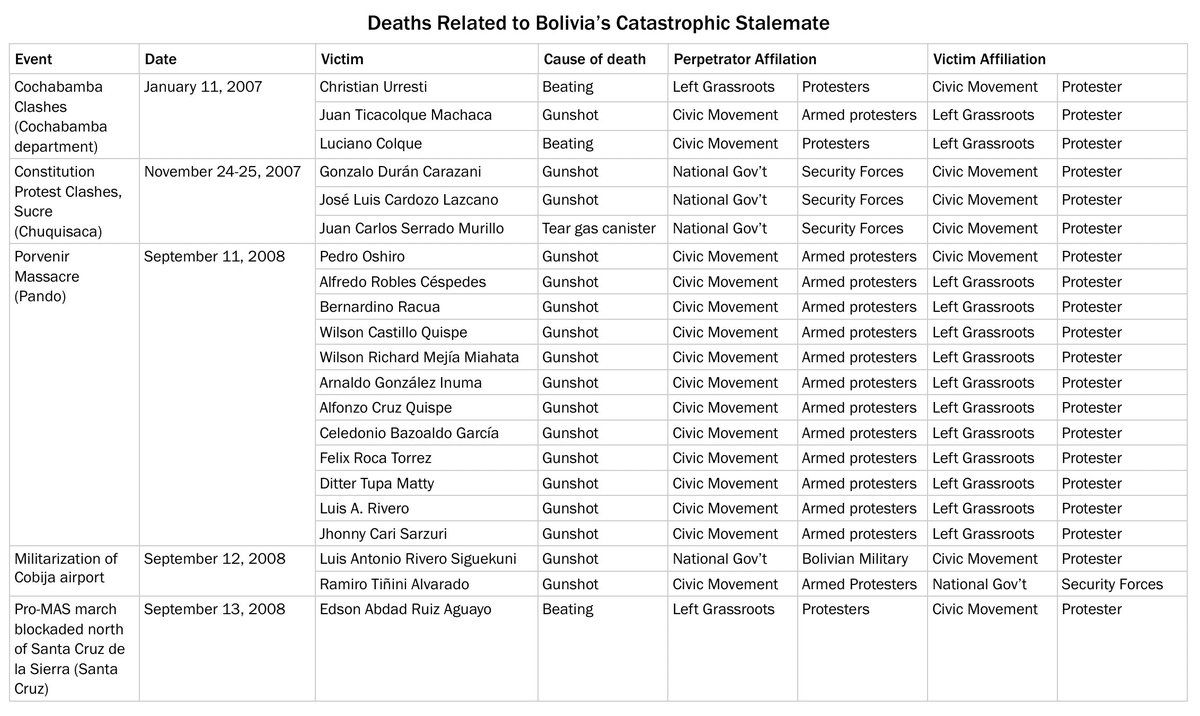-
A word about Wednesday's killings in Montero, Santa Cruz, the first two deaths in the #BoliviaElecciones2019 conflict. #Bolivia (thread)
-
The dead are Marcelo Terrazas, a leader of the Unión Juvenil Cruceñista (UJC), and Mario Salvatierra, a motorcycle taxi driver at the front lines of confrontations with MAS counter-protesters.
-
The overall scenario was that urban Montero has been part of the strike mobilization demanding the election results be overturned due to fraud. Pro-MAS-government counterprotesters arrived earlier in the day. paginasiete.bo/nacional/2019/11/1/la-policia-demoro-horas-para-actuar-en-montero-236039.html
-
Hospital reports indicate that 48 people were hospitalized after two clashes on Wednesday, and the majority were wounded by gunfire. eldeber.com.bo/155102_medio-centenar-de-heridos-son-atendidos-en-montero-tras-violenta-jornada-que-dejo-dos-muertos
-
Both the deaths and the gunfire mark a serious inflection in the course of dueling mobilizations over the future of Bolivia's democracy.
-
And both the nature of these clashes and the victims indicate the importance of an earlier Morales government vs. opposition faceoff, the "catastrophic stalemate of 2006-09.
-
The earlier crisis was organized along the lines of regions. Right-wing movements including the UJC called for the autonomy and virtual independence of Santa Cruz. These mobilizations had racist overtones (and often content) against the highland indigenous plurality of Bolivia.
-
Evo Morales and his government have been pushing the narrative that the current electoral protests are a repeat of the lowland separatist movement, even using images from 2008 to discredit the current protesters. brujuladigital.net/politica/garcia-linera-muestra-video-de-2008-para-acusar-a-carlos-mesa-de-generar-hechos-de-violencia
-
In the course of the catastrophic stalemate, urban separatist protesters often attacked offices of the MAS, and of its movement allies, even homes of its supporters in the cities. These attacks happened again during the day of conflict in Montero.
-
According to news coverage, the burnings in Montero were prompted by a false rumor that MAS protesters had burned an urban anti-election fraud protester to death. After the actual killings, urban protesters burned more.
-
This form of escalation (the arsons) shows how close to the surface tensions between parties, and between urbanites and pro-MAS rural movements can be.
-
On the other side, the gunfire and the killings by guns are highly unusual in inter-movement clashes in Bolivia. During the 2006-09 catastrophic stalemate, only right-wing civilians killed their opponents with guns, not the reverse.
-
Deadly clashes occurred between civilians in Cochabamba (Jan 2007), El Porvenir, Pando (Sep 2008), and in Tiquipaya, a town on the opposite site of Santa Cruz from Montero (Sep 2008).
-
In all there the right-wing forces brought firearms. In Pando, they killed 11 peasants and educators. In Cochabamba, they shot one peasant dead; 2 more people were beaten to death, one on each side.
-
Finally, in Tiquipaya, Santa Cruz, you had a scenario more like Montero: a left grassroots march confronting a right-wing crowd. During the clashes, a right-wing protester was beaten to death.
-
From 2006 to at least 2008, the Morales government generally worked to restrain the violence of its supporters, and withdrew police on many instances rather than provoke deadly clashes w/ its right-wing opponents.
-
This was true even as right-wing grupos de choque (clash groups) like the UJC repeatedly attacked, burned, and looted the offices (and homes and cars) of the government, the MAS, and its allies. And assaulted indigenous leaders in the streets.
-
At times this restrain was so extreme, I have labeled it "nonviolent statecraft." (Other times, it wasn't.)
-
Wednesday's events in Montero, are a very different strategy. Rather than blockading at a distance, or arriving unarmed, the pro-MAS side brought firearms, and evidently used them.
-
While clashes with sticks and beams are risky (witness Cochabamba this week), those with firearms can spin drastically out of control.
-
The inaction of the Bolivian National Police, under official control of the Morales government, represents a lost opportunity to avoid the deaths in Montero.
-
While Bolivian police often fall back rather than police destructive crowd behavior, permitting weapons and major arsons to proceed can have irreversible consequences. (But so too can shooting into an enraged crowd perpetrating these attacks.)
-
While Bolivian protests are often chaotic, militant, and even destructive, their costs in human lives is not huge. Two deaths mean a lot. A handful more could have major, and unpredictable political consequences. (end thread)
